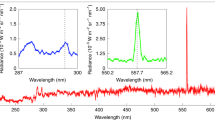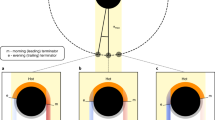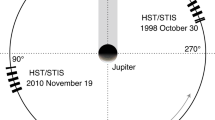Abstract
The 63-µm emission line from the ground electronic state fine-structure transition (3P1–3P2) of atomic oxygen, first suggested as a major source of thermospheric cooling by Bates1 and subsequently discussed theoretically2,3, has been measured over a range of thermospheric altitudes4–6. The rocket measurements showed that the downward intensity remained essentially constant between 85 and 100 km, as expected for an optically-thick emitting region. As a result, OI emission is now thought to be less important as a source of atmospheric cooling than upward radiation from the 5.3 µm band of NO (ref. 7). Nevertheless, measurements of the intensity distribution of OI emission in the lower thermosphere should help to discriminate between theoretical models8 and, in particular, address the appropriateness of ‘local thermodynamic equilibrium’ at these altitudes. We report here high spectral resolution measurements of OI emission at 30 km. The downward OI flux is measured to be (2.4 ± 0.5) × 10−5 W m−2 sr−1, somewhat larger than expected on the basis of previous rocket measurements or theoretical predictions. Furthermore, this value is found to be independent of zenith angle.
This is a preview of subscription content, access via your institution
Access options
Subscribe to this journal
Receive 51 print issues and online access
$199.00 per year
only $3.90 per issue
Buy this article
- Purchase on Springer Link
- Instant access to full article PDF
Prices may be subject to local taxes which are calculated during checkout
Similar content being viewed by others
References
Bates, D. R. Proc. phys. Soc. Lond. 64 B, 802–821 (1951).
Craig, R. A. & Gille, J. C. J. atmos. Sci. 26, 205–209 (1969).
Kockarts, G. & Peetermans, W. Planet. Space Sci. 18, 281–285 (1970).
Feldman, P. D. & McNutt, D. P. J. geophys. Res. 74, 4791–4793 (1969).
Offermann, D. & Grossmann, K. U. Geophys. Res. Lett. 5, 387–390 (1978).
Grossmann, K. U. & Offermann, D. Nature 276, 594–595 (1978).
Kockarts, G. Geophys. Res. Lett. 7, 137–140 (1980).
Iwagami, N. & Ogawa, T. Nature 298, 455–456 (1982).
Anderegg, M. et al. Astr. Astrophys. 82, 86–92 (1980).
Naylor, D. A. et al. Infrared Phys. (in the press).
McClatchey, R. A. et al. Air Force Cambridge Research Laboratory Rep. TR-73-0096 (1973).
Saykally, R. J. & Evenson, K. M. J. chem. Phys. 71, 1564–1566 (1979).
Goody, R. M. Atmos. Radiation, 125–130 (Oxford University Press, 1964).
Thorne, A. P. Spectrophysics, 307–311 (Chapman and Hall, London, 1974).
Grossmann, K. U., Barthol, P., Frings, W., Hennig, R. & Offermann, D. Adv. Space Res. 2, 111–114 (1983).
Offermann, D., Friedrech, V., Ross, P. & von Zahn, U. Planet. Space Sci. 29, 747–764 (1981).
Author information
Authors and Affiliations
Rights and permissions
About this article
Cite this article
Clark, T., Naylor, D., Boreiko, R. et al. Downward flux of atmospheric 63-µm emission from atomic oxygen at balloon altitudes. Nature 313, 206–207 (1985). https://doi.org/10.1038/313206a0
Received:
Accepted:
Issue Date:
DOI: https://doi.org/10.1038/313206a0
Comments
By submitting a comment you agree to abide by our Terms and Community Guidelines. If you find something abusive or that does not comply with our terms or guidelines please flag it as inappropriate.



